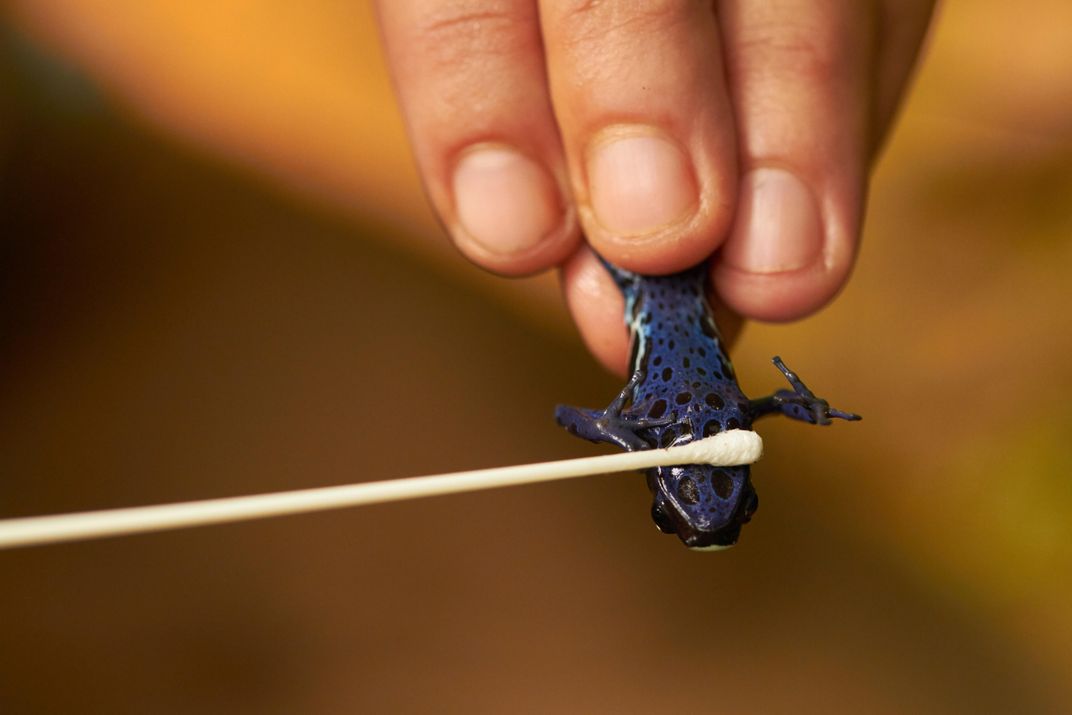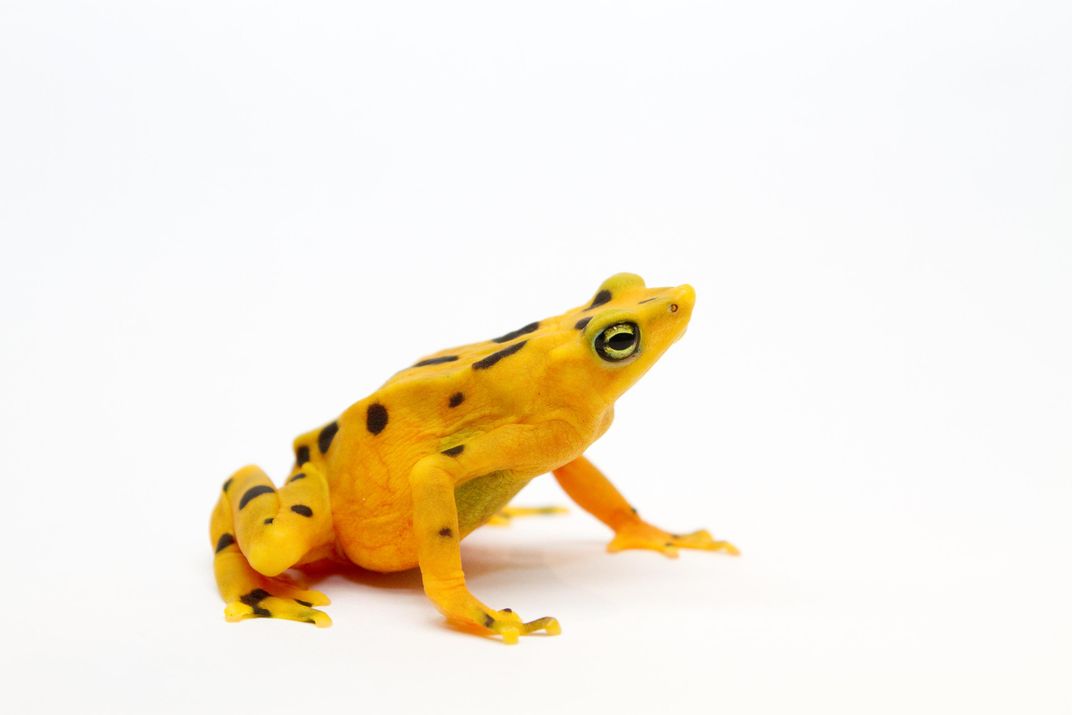A Ban on Salamanders Is Just Part of the Fight Against This Deadly Fungus
Scientists are deploying a variety of weapons as new clues emerge about the fungal diseases killing off amphibians
/https://tf-cmsv2-smithsonianmag-media.s3.amazonaws.com/filer/77/be/77be1d07-87b4-4bb9-9d28-23bf1f2dddf3/3470286309_340b30f86e_o.jpg)
Species of all types are disappearing around the globe, but no group may be more threatened than amphibians. One recent analysis found that 43 percent of amphibian species are on the decline and nearly a third are officially threatened. Scientists have also counted 168 species that have gone extinct in the wild, and more than half of those extinctions have occurred in the last few decades.
One big factor has been Batrachochytrium dendrobatidis, a fungal disease also known as chytrid that was virtually unknown two decades ago. Since its discovery, scientists have witnessed mass die-offs of amphibians, especially frogs, around the world, sometimes happening overnight.
Now, a related fungal disease is spreading among salamanders, B. salamandrivorans, or Bsal, and scientists are racing to apply what they have learned about chytrid to prevent this new threat from devastating amphibians in North America.
Amphibians are an integral part of the ecosystem, providing a link between the aquatic and terrestrial worlds, Karen Lips, who studies the animals at the University of Maryland College Park, said this week at the 2016 meeting of the American Association for the Advancement of Science (AAAS) in Washington, D.C.
Amphibians are key predators of insects—many of which can transmit diseases such as Zika and dengue to humans—and they serve as meals for other creatures. When frogs disappear, “there are big impacts on pretty much all aspects of the ecosystem,” from water quality to snake abundance, says Lips, who has seen the effects of chytrid on amphibians in Panama.
The animals have also become key in research on limb regeneration. That makes amphibian declines, which may be even worse than reported, especially worrisome, Lips says. So researchers around the world are jumping in to find out as much as they can about the attacking fungi.
“The discovery of these two diseases has changed the way we think about pathogens,” says Ana Longo, of the University of Maryland College Park and the Smithsonian Conservation Biology Institute. When chytrid first appeared, scientists were reluctant to believe that a single pathogen could be so dangerous to more than a single species.
While studies have since shown that it's possible, scientists they have also discovered that there are several kinds of Batrachochytrium. Some appear to be endemic in certain regions, such as Brazil, Switzerland and Korea, and amphibians there are able to tolerate the fungus.
But two other versions have spread widely, largely due to the pet trade. These invasive fungi are mostly responsible for the mass die-offs of frogs and other amphibians in the wild.

Scientists have also recognized that the chytrid epidemic began decades earlier than they thought. By studying amphibians in natural history collections, they have been able to see that declines in some species, such as the Yosemite toad, occurred around the same time as the arrival of chytrid in a particular region.
“Museums are giving us a view of the past that may help us interpret the status of present-day populations,” says Vance Vredenburg, an amphibian ecologist at San Francisco State University.
One big takeaway so far is that the fungus may not actually doom all frogs, as scientists once feared. Many factors can interact to determine whether a population—or an entire species—survives. For instance, while chytrid thrives in cooler climates, the local climate and ecology can influence the spread of the disease and amphibian susceptibility.
Interactions with the other microbes living on an animal’s skin may also play a role, along with the response of its immune system. Some researchers are now working on probiotics that might help a frog fight off a chytrid infection. And zoos, including the Smithsonian National Zoo, are raising animals that have gone extinct in the wild, such as the Panamanian golden frog, with plans to eventually reestablish lost populations once they figure out how to control the fungus.

Such efforts are giving scientists a head start for tackling Bsal, a disease that was first officially described in 2013. Thought to be native to Asia, this fungus arrived in the Netherlands via the pet trade and spread through Europe from there. The disease has not yet been found in North America, but it could be a huge problem if it makes the leap across the Atlantic.
“The threat of the new salamander-eating chytrid fungus is something we should all be very concerned about, because the Appalachian region is the world’s major biodiversity hot spot for salamanders,” says Brian Gratwicke, a conservation biologist at the National Zoo. “We have a responsibility do everything we can to preserve them as an important feature of the continent’s biodiversity.”
The U.S. Geological Survey has developed a rapid-response plan for handling suspicious salamander deaths, and herpetologists would love to see any dead salamanders people find. The National Zoo has also teamed up with a citizen-science project, the Amphibian Survival Alliance, to test pet salamanders for the fungus. In the meantime, researchers are hoping to apply the lessons they are learning about chytrid biology to Bsal.
But for now, the best way to keep U.S. salamanders safe is to keep Bsal out of the country. To that end, the U.S. Fish and Wildlife Service implemented a ban earlier this year on the import and interstate trade of 201 salamander species that could transmit Bsal.
“We know that there’s no treatment,” Lips said, “so it’s pretty obvious that the only thing that is going to give us any amount of time to come up with a solution or treatment … is to keep it out as long as possible.”
/https://tf-cmsv2-smithsonianmag-media.s3.amazonaws.com/accounts/headshot/Sarah-Zielinski-240.jpg)
/https://tf-cmsv2-smithsonianmag-media.s3.amazonaws.com/accounts/headshot/Sarah-Zielinski-240.jpg)